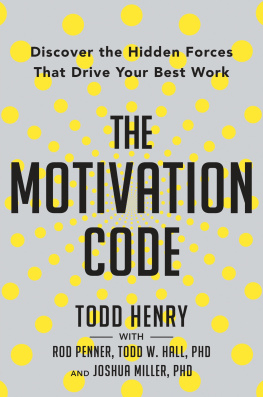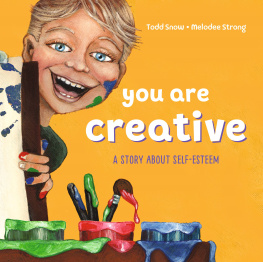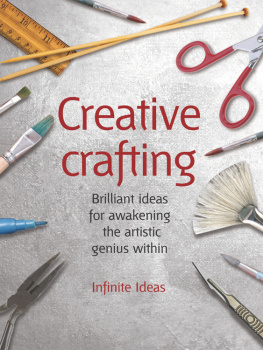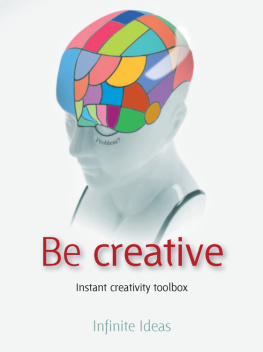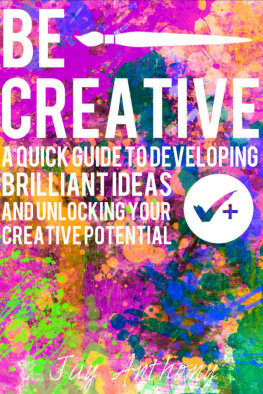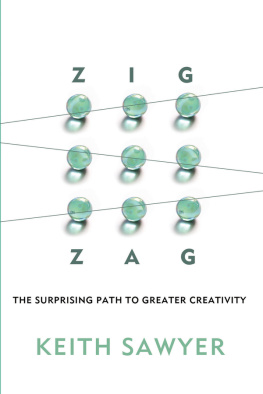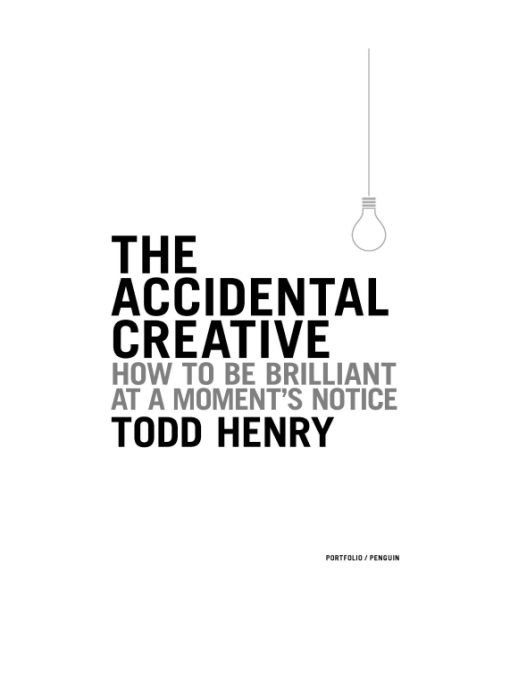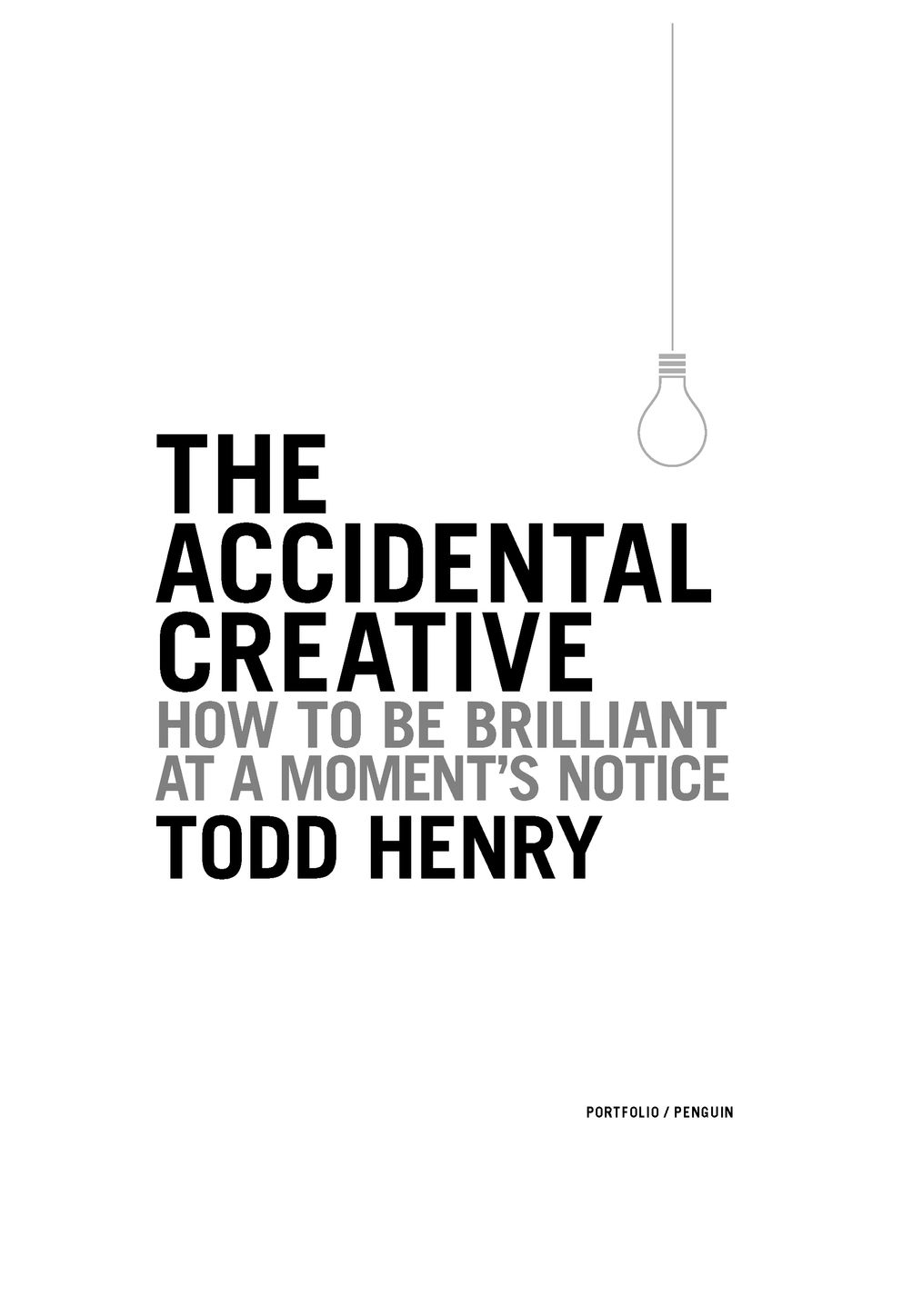Table of Contents
To Ethan, Owen, and Ava, who regularly show me what creativity is all about, and to Rachel for the freedom.
I love you all.
INTRODUCTION
THE ACCIDENTAL CREATIVE
In some circles, the word creative has recently morphed from adjective to noun. If you are one of the millions among us who make a living with your mind, you could be tagged a creative. Every day, you solve problems, innovate, develop systems, design things, write, think, and strategize. You are responsible for moving big conceptual rocks, crafting systems that form the foundations for future growthcreating value that didnt exist before you arrived on the scene.
Maybe you didnt set out to be a creative. In fact, perhaps you even cringe when you hear the word applied to you. Understandably, the tag creative sometimes conjures up images of SoHo advertising gurus flitting about in five-hundred-dollar designer jeans. You may prefer the term strategist or manager, or something else that feels more concrete. Call yourself anything you want, but if youre responsible for solving problems, developing strategies, or otherwise straining your brain for new ideas, Im going to call you a creativeeven if you ended up being one accidentally.
Some people deliberately choose a career that allows them to exercise their creativity on a daily basis. They make their livings designing, writing, developing ad campaigns, or doing some other kind of conceptual work. They get to do something they love, and someone gives them money for it. Speaking as one of the last group, I think its a pretty great deal. On our best days it seems almost unfair that we get paid to do what we do, but on our worst days our jobs feel pretty much like any other. Though creative fields may sound exotic to strangers at cocktail parties, our day-to-day work can often feel a lot like following recipes, taking familiar ingredients and mixing them together in slightly different ways.
Whichever type you are, creative or accidental creative, this book will help you create faster and more effectively than you ever imagined possible.
For the traditional creatives, such as designers, writers, visual artists, musicians, and performers, this book will help you establish enough structure in your life to get the most out of your creative process. It will also teach you how to stay engaged and prolific over the long term, which is often a problem for artists who must produce continually on demand.
For the nontraditional creatives, such as managers, strategists, consultants, salespeople, and client service reps, this book will help you unlock your latent creative abilities. You will learn how to do what many brilliant creatives already do instinctively, and how to do it consistently. In short, you will learn how to be brilliant when it counts the most.
There are tremendous benefits to doing creative work. You get to add unique value, carve out your own niche in the marketplace, and watch your notions and hunches go from conception to execution; could there be any type of work more gratifying? But the flip side of this is that whether you are a designer, manager, writer, consultant, or programmer, you are required to create value each and every day without reprieve. The work never ends, and as long as there is just one more thing to think about, finding time to rest can be difficult. Your primary tool, your mind, goes with you everywhere. If your job is to solve problemsto createthen you are always looking for new ideas. In addition, you wont always have the option of going back to your desk to quietly brainstorm, vetting your ideas one by one. As a creative, you will regularly find yourself in situations that require you to generate brilliant ideas at a moments notice.
This is no easy feat. If you want to deliver the right idea at the right moment, you must begin the process far upstream from when you need that idea. You need to build practices into your life that will help you focus your creative energy. There is a persistent myth in the workplace that creativity is a mystical and elusive force that sits somewhere between prayer and the U.S. tax code on the ambiguity scale. But the reality is that you can unquestionably increase your capacity to experience regular flashes of creative insightcreative accidentsbring the best of who you are to your work, and execute more effectively, all by building purposeful practices into your life to help you do so. These practices will help you stay engaged and productive over the long term without experiencing the rampant burnout that often plagues creative workers.
In other words, purposeful preparation and training using the tools in this book will directly increase your capacity to do brilliant work, day after day, year after year.
If you want to deliver the right idea at the right moment, you must begin the process far upstream from when you need that idea.
Why am I so sure it works? Ive spent years working with traditionally creative workers (designers, writers, musicians, filmmakers) and traditionally noncreative workers (salespeople, real estate agents, accountants), helping them develop their creative strength and stamina. In addition to this work with my company, Accidental Creative, and my experience as a leader of creative teams, Ive also conducted countless interviews with creative thinkers, productivity experts, and organizational leaders, such as David Allen (Getting Things Done); Seth Godin (Linchpin, Tribes, Purple Cow); riCardo Crespo (Senior Vice President, Global Creative Chief, Twentieth Century Fox FCP); Richard Westendorf (Executive Creative Director, Landor Associates); Scott Belsky (CEO of Behance and author of Making Ideas Happen); Tony Schwartz (The Way Were Working Isnt Working, The Power of Full Engagement); and Keith Ferrazzi (Never Eat Alone, Whos Got Your Back); among others.
Astonishingly, Ive found little difference among the pressures experienced by these diverse groups of people. They each use a different set of specific skills in their work, of course. While a designer will solve a problem visually, a manager may solve it by developing a new process. But theyre both employing the same creative tools and wrestling with many of the same obstacles. The good news is that, regardless of role, you can improve your ability to generate good ideas consistently if you are willing to be a little more purposeful in how you approach the creative process. It wont be easy, but in the end your work will be more satisfying, more productive, and more fun.
HOW TO READ THIS BOOK
This book is divided into two sections. Chapters 1 through 3 deal with many of the pressures faced by creatives in the workplace, and why doing brilliant work day after day can be so challenging. Chapters 4 through 10 offer some practices that you can implement to help you experience higher levels of creative insight on a daily basis. While you may be tempted to skip ahead to the latter portion of the book, I would recommend that you begin with the first chapters. Some dynamics that affect the everyday experiences of the creative are painfully felt but are seldom diagnosed, and can have a dramatic effect on your ability to do your best work.
Anyone can improve his ability to generate good ideas consistently if willing to be a little more purposeful in how to approach the creative process.



